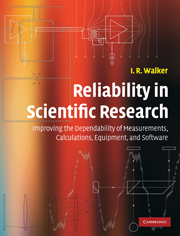 Reliability in Scientific Research
Reliability in Scientific Research Book contents
- Frontmatter
- Contents
- Preface
- List of abbreviations
- 1 Basic principles of reliability, human error, and other general issues
- 2 Mathematical calculations
- 3 Basic issues concerning hardware systems
- 4 Obtaining items from commercial sources
- 5 General points regarding the design and construction of apparatus
- 6 Vacuum-system leaks and related problems
- 7 Vacuum pumps and gauges, and other vacuum-system concerns
- 8 Mechanical devices and systems
- 9 Cryogenic systems
- 10 Visible and near-visible optics
- 11 Electronic systems
- 12 Interconnecting, wiring, and cabling for electronics
- 13 Computer hardware and software, and stored information
- 14 Experimental method
- Index
- References
12 - Interconnecting, wiring, and cabling for electronics
Published online by Cambridge University Press: 05 June 2012
- Frontmatter
- Contents
- Preface
- List of abbreviations
- 1 Basic principles of reliability, human error, and other general issues
- 2 Mathematical calculations
- 3 Basic issues concerning hardware systems
- 4 Obtaining items from commercial sources
- 5 General points regarding the design and construction of apparatus
- 6 Vacuum-system leaks and related problems
- 7 Vacuum pumps and gauges, and other vacuum-system concerns
- 8 Mechanical devices and systems
- 9 Cryogenic systems
- 10 Visible and near-visible optics
- 11 Electronic systems
- 12 Interconnecting, wiring, and cabling for electronics
- 13 Computer hardware and software, and stored information
- 14 Experimental method
- Index
- References
Summary
Introduction
Among the most common problems encountered when dealing with electronic items are those caused by faulty contacts, connectors, wires and cables. For example, bad solder joints are among the most frequent causes of failures in electronic devices in general. In any given electronic system, the most unreliable components will be its connectors and cables. (Perhaps somewhat surprisingly, the number of connector problems that occurred during the Apollo space program was greater than that of all other problems combined.) More specifically, faulty connectors and cables are an important source of trouble in experimental work, in the form of unreliable measurements and wasted time.
Information on this subject is widely dispersed. The purpose of the following chapter is to bring together knowledge about these mundane but troublesome items from some of the various scattered sources.
Some contact, connector, wire, and cable problems are:
(a) excessively high or low resistances, or complete open or short circuits,
(b) noisy contacts (perhaps in the form of 1/f noise),
(c) production and reception of electromagnetic interference (including crosstalk between nearby wires and cables),
(d) leakage currents over insulators in high-impedance circuits,
(e) noise produced as a result of cable vibrations in high-impedance circuits (“microphonics”),
(f) nonlinear I–V characteristics of poor-quality contacts (i.e. they can become non-ohmic – this may lead to interference with sensitive measurements due to rectification of electromagnetic noise in the environment, and also signal distortion),
(g) reflections on cables at radio (and particularly microwave) frequencies, owing to impedance mismatches,
(h) arcing and corona discharge at contacts, and in cables and connectors, at high voltages,
[…]
- Type
- Chapter
- Information
- Reliability in Scientific ResearchImproving the Dependability of Measurements, Calculations, Equipment, and Software, pp. 413 - 486Publisher: Cambridge University PressPrint publication year: 2011


